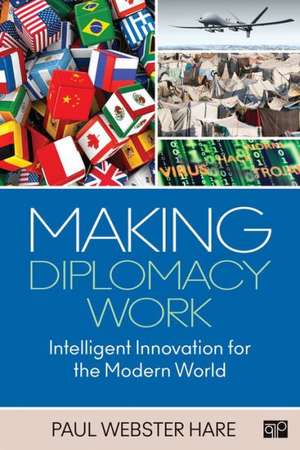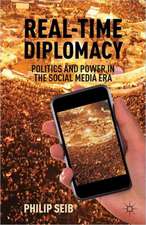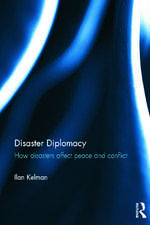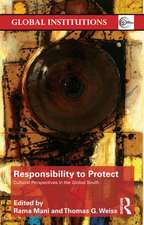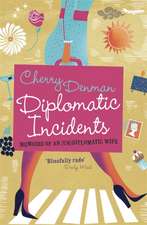Making Diplomacy Work: Intelligent Innovation for the Modern World
Autor Paul Webster Hareen Limba Engleză Paperback – 6 apr 2015
Bringing diplomacy to life for students, every chapter of the book is full of many real world examples from contemporary diplomacy, including events from the author's own experience. Chapters also feature extended case studies, covering topics like diplomatic immunity and privileges, the achievements and failures of institutions like the UN, successes and failures in diplomatic negotiations, the effectiveness of international law and its impact on diplomacy, and more.
Preț: 560.10 lei
Preț vechi: 727.40 lei
-23% Nou
Puncte Express: 840
Preț estimativ în valută:
107.18€ • 112.41$ • 89.22£
107.18€ • 112.41$ • 89.22£
Carte tipărită la comandă
Livrare economică 01-15 aprilie
Preluare comenzi: 021 569.72.76
Specificații
ISBN-13: 9781452276489
ISBN-10: 145227648X
Pagini: 416
Dimensiuni: 152 x 229 x 32 mm
Greutate: 0.5 kg
Ediția:1
Editura: SAGE Publications
Colecția CQ Press
Locul publicării:Washington DC, United States
ISBN-10: 145227648X
Pagini: 416
Dimensiuni: 152 x 229 x 32 mm
Greutate: 0.5 kg
Ediția:1
Editura: SAGE Publications
Colecția CQ Press
Locul publicării:Washington DC, United States
Recenzii
"A superb and compelling treatment of diplomacy's evolution as a dynamic institution. Hare provides an unvarnished look at diplomacy's continued relevance as well as its severe challenges in a world populated by diverse actors, including governments, companies, and NGOs. An essential primer for anyone entering this ancient and noble profession."
“Making Diplomacy Work is extremely comprehensive; it is clearly written by someone who has direct first-person experience in the practice of diplomacy. It covers territory that I have not seen in other textbooks. This is a welcomed addition to the textbook landscape.”
“The case studies are excellent and add a great deal to the book. The author's discussions about his own experience as a diplomat are also quite interesting. The author is clearly an accomplished expert in his field.”
“Making Diplomacy Work is extremely comprehensive; it is clearly written by someone who has direct first-person experience in the practice of diplomacy. It covers territory that I have not seen in other textbooks. This is a welcomed addition to the textbook landscape.”
“The case studies are excellent and add a great deal to the book. The author's discussions about his own experience as a diplomat are also quite interesting. The author is clearly an accomplished expert in his field.”
Cuprins
Preface
Acknowledgments
Introduction
About the Author
Chapter 1: Diplomacy in History
The Building Blocks of Modern Diplomacy
Diplomacy and Collective Action
Revolutions, Wars, and the Changing World
States and Leaders Decline
Diplomacy and Foreign Policy
Suggestions for Further Reading
Chapter 2: Who Are the Diplomats and How Do They Operate?
The Evolution of the Diplomatic Cadre
The Use of Intelligence
Professionals or Politicians?
Diplomatic Privileges and Immunities
The VCDR and VCCR
What Is Changing In Diplomats’ Behavior?
Diplomatic Asylum
Case Studies
… And Personally
Suggestions for Further Reading
Chapter 3: The Institutions of Bilateral Diplomacy – Precedence, Protocol, Ministries, Embassies
Ministries
The Modern Ministries of Foreign Affairs
Examples of Ministries of Foreign Affairs in Action
Roles of Embassies and Consulates
Embassies Losing Their Grip?
How Are Embassies Staffed?
New and Old Tasks
Competition
The Future of Diplomatic Missions
Case Studies – How Embassies Operate
Nevertheless Useful
Suggestions for Further Reading
Chapter 4: The Institutions of Multilateral Diplomacy
The United Nations
The Charter of the United Nations
The Organs of the UN
The Security Council
ESOSOC
International Court Of Justice
The UN Secretariat
Diplomats and the UN
The UN’s Development
Different Worlds: Different UN
Case Studies: The Charter And The UNSCR: The Iraq Crises of 1990-2001 and 2003
Following Diplomatic and Military Success: New Tasks
UNSCOM and UNMOVIC Success
Conclusion
Suggestions for Further Reading
Chapter 5: Regional Diplomacy and the Gs. The Rise of Summitry
The Non-Aligned Movement
The European Union
Special Competencies
The EU and Domestic Policies
The EU Institutions: A Modern Crisis of Supranational Diplomacy?
Is Accountability a Part of the EU?
The EU’s Success in Diplomacy
The EU as a Diplomatic Service
The EU Case Studies
The EU Case Studies
The African Union
Asean
Latin America
Other Regions
Other Groups
Summits and the Gs
Innovation from Groups
Issue Groups
Suggestions for Further Reading
Chapter 6: Negotiations
Framing an Issue
The Raw Material of Diplomatic Negotiations
Culture
Elements Required For Success: Pre-Negotiations
Mediation
Strategy and Progress
Case Study: The INF Negotiation 1980-1987
Continuous Negotiation
Case Study: Negotiation in Cuba
Suggestions for Further Reading
Chapter 7: Public Diplomacy
Public Diplomacy in the Past
Propaganda?
Public Diplomacy for Today’s World
Effective Public Diplomacy
Public Diplomacy in Practice
Conclusions and Case Studies
Unlimited Ideas
Suggestions for Further Reading
Chapter 8: Public Goods: Treaties and International Law
Treaties
Laws, Rules, and Diplomacy
War and Its Rules
The United Nations
Genocide
Terrorism
Human Rights
Non-Proliferation of Nuclear Weapons
Climate Change
World Trade/World Finance
Diplomacy and Law: The Problem of Enforcement and Implementation
Suggestions for Further Reading
Chapter 9: The New Diplomatic Agenda: The Challenges for Diplomatic Reform
Why Reform?
Diplomatic Priorities
The New Agenda – Corruption
Decline of Sovereign States
The New Agenda? Diplomacy Steps Up
Diplomatic Reform
Sovereign Wealth Funds
Development Assistance in the Diplomatic Agenda
Case Study of the New Agenda – Nation Building in Afghanistan
Conclusion
Suggestions for Further Reading
Chapter 10: The Non-State Actors: Global Citizens and Global Diplomacy
The Globalization of Identity – The International Community?
The Non-State Actors
Global Citizens?
States and Non-States in Diplomacy
Beyond States – The Non-State Advantage?
The Battle Of Ideas – States v. Non-States?
Common Need: Common Reform
Case Study – Haiti and the Earthquake – State and Non-State, The Republic Of NGOs, The Alms
Merchant
Conclusion
Haiti and Rwanda
Suggestions for Further Reading
Chapter 11: The Continuing Information and Communication Revolution – Awaiting the Response of Diplomacy
The ICR and E-Diplomacy
International Chatter
The ICR and A Shrinking World
Diplomacy and the Apps
Oh – And What about Radio and Television?
Global Governance of the ICR
The Positives and Negatives For Diplomacy – Communications Unlocks Potential And Produces
New Weapons
Communications: It’s A Small World: The Global Whistle Blower and Global Activism
Conclusion
Suggestions for Further Reading
Chapter 12: Diplomacy in 2025
Diplomacy in 1945
The Reassertion of Diplomacy
Diplomacy Still Valid for 2025
Looking At the Future – The Issue of Stovepipes
Complex Issues or Inadequate Diplomacy?
The Forums for Discussion
Permanent Crises
Future Crises
Intelligent, Versatile, Resourceful: The Diplomat In 2025
Suggestions for Further Reading
Chapter 13: Diplomacy for the Ages
15 Ideas to Raise Diplomacy’s Batting Average
Final Thoughts
Acknowledgments
Introduction
About the Author
Chapter 1: Diplomacy in History
The Building Blocks of Modern Diplomacy
Diplomacy and Collective Action
Revolutions, Wars, and the Changing World
States and Leaders Decline
Diplomacy and Foreign Policy
Suggestions for Further Reading
Chapter 2: Who Are the Diplomats and How Do They Operate?
The Evolution of the Diplomatic Cadre
The Use of Intelligence
Professionals or Politicians?
Diplomatic Privileges and Immunities
The VCDR and VCCR
What Is Changing In Diplomats’ Behavior?
Diplomatic Asylum
Case Studies
… And Personally
Suggestions for Further Reading
Chapter 3: The Institutions of Bilateral Diplomacy – Precedence, Protocol, Ministries, Embassies
Ministries
The Modern Ministries of Foreign Affairs
Examples of Ministries of Foreign Affairs in Action
Roles of Embassies and Consulates
Embassies Losing Their Grip?
How Are Embassies Staffed?
New and Old Tasks
Competition
The Future of Diplomatic Missions
Case Studies – How Embassies Operate
Nevertheless Useful
Suggestions for Further Reading
Chapter 4: The Institutions of Multilateral Diplomacy
The United Nations
The Charter of the United Nations
The Organs of the UN
The Security Council
ESOSOC
International Court Of Justice
The UN Secretariat
Diplomats and the UN
The UN’s Development
Different Worlds: Different UN
Case Studies: The Charter And The UNSCR: The Iraq Crises of 1990-2001 and 2003
Following Diplomatic and Military Success: New Tasks
UNSCOM and UNMOVIC Success
Conclusion
Suggestions for Further Reading
Chapter 5: Regional Diplomacy and the Gs. The Rise of Summitry
The Non-Aligned Movement
The European Union
Special Competencies
The EU and Domestic Policies
The EU Institutions: A Modern Crisis of Supranational Diplomacy?
Is Accountability a Part of the EU?
The EU’s Success in Diplomacy
The EU as a Diplomatic Service
The EU Case Studies
The EU Case Studies
The African Union
Asean
Latin America
Other Regions
Other Groups
Summits and the Gs
Innovation from Groups
Issue Groups
Suggestions for Further Reading
Chapter 6: Negotiations
Framing an Issue
The Raw Material of Diplomatic Negotiations
Culture
Elements Required For Success: Pre-Negotiations
Mediation
Strategy and Progress
Case Study: The INF Negotiation 1980-1987
Continuous Negotiation
Case Study: Negotiation in Cuba
Suggestions for Further Reading
Chapter 7: Public Diplomacy
Public Diplomacy in the Past
Propaganda?
Public Diplomacy for Today’s World
Effective Public Diplomacy
Public Diplomacy in Practice
Conclusions and Case Studies
Unlimited Ideas
Suggestions for Further Reading
Chapter 8: Public Goods: Treaties and International Law
Treaties
Laws, Rules, and Diplomacy
War and Its Rules
The United Nations
Genocide
Terrorism
Human Rights
Non-Proliferation of Nuclear Weapons
Climate Change
World Trade/World Finance
Diplomacy and Law: The Problem of Enforcement and Implementation
Suggestions for Further Reading
Chapter 9: The New Diplomatic Agenda: The Challenges for Diplomatic Reform
Why Reform?
Diplomatic Priorities
The New Agenda – Corruption
Decline of Sovereign States
The New Agenda? Diplomacy Steps Up
Diplomatic Reform
Sovereign Wealth Funds
Development Assistance in the Diplomatic Agenda
Case Study of the New Agenda – Nation Building in Afghanistan
Conclusion
Suggestions for Further Reading
Chapter 10: The Non-State Actors: Global Citizens and Global Diplomacy
The Globalization of Identity – The International Community?
The Non-State Actors
Global Citizens?
States and Non-States in Diplomacy
Beyond States – The Non-State Advantage?
The Battle Of Ideas – States v. Non-States?
Common Need: Common Reform
Case Study – Haiti and the Earthquake – State and Non-State, The Republic Of NGOs, The Alms
Merchant
Conclusion
Haiti and Rwanda
Suggestions for Further Reading
Chapter 11: The Continuing Information and Communication Revolution – Awaiting the Response of Diplomacy
The ICR and E-Diplomacy
International Chatter
The ICR and A Shrinking World
Diplomacy and the Apps
Oh – And What about Radio and Television?
Global Governance of the ICR
The Positives and Negatives For Diplomacy – Communications Unlocks Potential And Produces
New Weapons
Communications: It’s A Small World: The Global Whistle Blower and Global Activism
Conclusion
Suggestions for Further Reading
Chapter 12: Diplomacy in 2025
Diplomacy in 1945
The Reassertion of Diplomacy
Diplomacy Still Valid for 2025
Looking At the Future – The Issue of Stovepipes
Complex Issues or Inadequate Diplomacy?
The Forums for Discussion
Permanent Crises
Future Crises
Intelligent, Versatile, Resourceful: The Diplomat In 2025
Suggestions for Further Reading
Chapter 13: Diplomacy for the Ages
15 Ideas to Raise Diplomacy’s Batting Average
Final Thoughts
Descriere
Taking a fresh look at actual practice, this book sets diplomacy in its contemporary context and analyzes the major factors that have changed the nature of the intelligent conduct of diplomacy.
